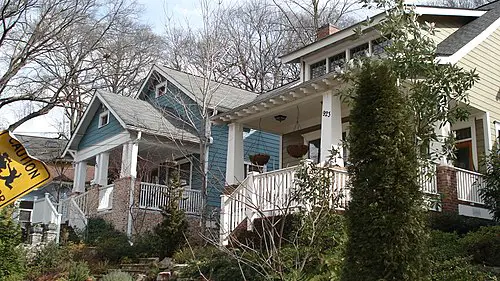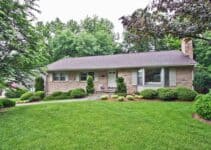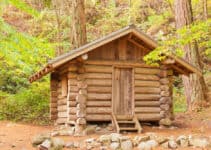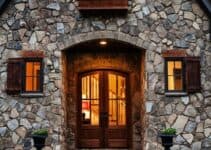When it comes to different types of quaint British property, you might be surprised to learn that there are fairly strict definitions of what each one means. Even so, it’s common for the terms cottage and bungalow to be used interchangeably.
So, when it comes to cottage vs. bungalow, what’s the difference? The biggest difference of a cottage vs. bungalow is that the latter is always a single-storey. Cottages, on the other hand, are 2-storey and have other architectural features that define them as a clear category of building.
In this article, we’ll go into more detail about the differences of a cottage vs. bungalow. First, it’s probably easiest to provide a clear definition of each term.
What is a Bungalow?
A bungalow, in the UK at least, is a single-storey residential building. It must have a sloping roof that’s typically covered in tiles, and the property may be surrounded by a veranda. Not to be confused with a granny flat.
It’s not uncommon for a bungalow to have a second storey thanks to a loft conversion. However, to remain a bungalow, it must keep its sloping roof, which necessitates dormer windows.

Define Bungalow
The correct term for this kind of property is a chalet bungalow.
The bungalow was first built in the UK in 1869, in a seaside town called Westgate-on-Sea, Kent. The name comes from India, meaning ‘a house built in the Bengali style’.
However, there’s no clear evidence that Bengali homes were actually the inspiration for the original bungalow design.

The Definition of a Cottage
A cottage is defined in English law as a small residential property that doesn’t have land. In Scotland, the equivalent term is a croft, and in Welsh, it’s bwthyn. There’s no strict definition for how small a cottage should be, but it’ll typically be 2-3 bedrooms.
By extension, a cottage can be detached, semi-detached, or a terrace. In the 19th and 20th centuries, terraced cottages were common as housing for workers.
These would be lucky to have 2 bedrooms and would more likely have a single room upstairs (for storage or children), while the adults would sleep downstairs.
Cottages can trace their origin back to the medieval period, when they were homes for cotters. A cotter was a semi-independent peasant who lived on owned lands but had certain rights that put them above ‘regular’ peasants.
A cotter is named for the cottage in which they lived, and the etymology of this word comes from the Old Norse word kot, meaning ‘hut’.
Is a Cottage a Bungalow?
A cottage and a bungalow aren’t always the same thing. However, to make it a bit more confusing, a bungalow can be a cottage, but a cottage isn’t always a bungalow. We can understand this in more detail by using the definitions given above.
Cottages are broader in their definition, as they just need to be small buildings. Therefore, a bungalow can be a cottage in that it’s small, similar to a lodge, but it must be a single-storey cottage.
If a cottage has a second storey that was built as part of the original construction, it’s just a cottage.

Cottage Style vs. Bungalow
In the UK, the term cottage is often used as a romantic descriptor of a small, rural property that looks fairly quaint.
A bungalow, however, is often associated with a less attractive kind of property, mainly thanks to their mass production in the inter-war period.
However, the term ‘cottage style’ caught on in the USA around the same time. It was used to refer to an A-frame house that followed the same roofing design as a traditional cottage.
In typical American fashion, their definition of bungalow is different, too – they can even have 2 floors!
Differences Between Cottages and Bungalows
Now that we’ve got an idea of what each type of building is, we can look at some of the main differences that separate them. Some are more obvious than others, but they’re all just as important.
1. Age
Cottages can be hundreds of years old. While we won’t see many cottages from the 11th century, it’s not uncommon to see buildings dating back to the 16th century or a bit before.
Bungalows, on the other hand, are a relatively new design. As a general rule, bungalows you’ll see across the UK will have been built in the 20th century.
There aren’t many 19th-century bungalows left because they weren’t built with the kind of construction techniques that last.
In fact, changes in design are so clear cut that we can age bungalows just by looking at them. There was a massive boom of bungalows in seaside towns in the inter-war period.
These bungalows are most commonly square. The next boom was in the 1960s, and these are more rectangular.
2. Footprint
Cottages, by definition, are small. Also, because they have a second-storey, their footprint is significantly smaller than that of a bungalow. A cottage will usually have 2-3 bedrooms, although this can depend on when it was built.
Bungalows have a much larger footprint. After all, if they can’t go up then they need to go out. It’s part of the reason why they’re not built very often; they simply take up too much space.
3. Roofing materials
Cottages can be tiled or thatched depending on their age and design. A thatched building will almost always be a cottage and is arguably the textbook definition of cottage.
Bungalows, however, will always have tile roofs. This is related to their recent age, as thatching had fallen out of popularity as a roofing material by this point due to the cost-effectiveness of tiles.
4. Historical definition
This is less of a difference and more of a fun fact. Although bungalows don’t have a set amount of land around them, they usually have more than semi-detached or terrace houses in a similar area.
It’s not uncommon to see a bungalow completely surrounded by green space within its property boundaries.
Cottages, however, have a much more interesting definition of land. Until the Tudor period, a cottage could only be a cottage if it had at least 4 acres of land within its property boundary.
This is what the cotter would use to grow their food and rear their livestock. It was one of the key residential rights that separated them from peasants.
However, after the Enclosures Act (which was first introduced in 1604), the definition was legally changed. It specifically removed the right of land for a cotter.
While properties would still have a small garden, there’s a big difference between 4 acres and a bit of a lawn.
In Wales, things get more interesting still. A Welsh cottage (bwthyn) could be built using a folkloric tradition called Ty unnos, which translates to ‘house in the night’.
In short, if someone could build a cottage in a single night, they got the freehold to the land on which they’d built it. The land was defined as the distance the person could throw an axe in a diagonal line.
Unfortunately, there’s no real evidence that these homes were ever built, or legally allowed if they were. One example that’s believed to be a one-night house is Ty Hyll in Snowdonia. It translates to ‘ugly house’ despite it being very cute.
5. Variations
There aren’t many variations of the cottage in Britain. You’ve probably heard the term ‘holiday cottage’ in reference to second homes or short-term rentals. Again, these are quite small buildings, often in rural areas.
Part of the reason why there’s not much variation is that the definition of cottage is so broad. After all, it’s quite difficult to say one cottage is a certain style while another one is different if your only real decider is that it’s small. Perhaps the main exception to this is the thatched cottage.
Bungalows, however, have quite a few variations. There’s the previously-mentioned chalet cottage, which has dormer windows in its roof for the second storey. If you go to America, you’ll see lots of other variations on the bungalow design, including:
· Ranch bungalow – bedrooms are on one side, ‘public’ rooms are on the other
· Chicago bungalow – brick buildings with 1.5 storeys (a small bedroom)
· Bungalow colony – a cluster of summer rental homes built around a family vacation park
· Raised bungalow – a property whose basement partially extends above ground, creating something of a half-storey
Finally, there’s the ultimate bungalow. This is a 2-storey property built along the same lines as a bungalow. It has a large footprint and a similarly shaped roof, despite having 2 or more floors.
Ultimate bungalows are built almost exclusively around California.
What is a Cottage vs. Bungalow
Hopefully, you now know everything you could need about the difference of a cottage vs. bungalow. It can be easy to confuse the terms because one can be the other, but not all the time.
Bungalows and Cottages
So, next time you’re out travelling around the UK, make sure you correct anyone who uses the term cottage (or bungalow) incorrectly! You’ll even be able to drop some cottage and bungalow facts on them.



